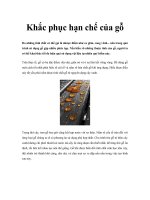Tài liệu National Semiconductor`s Temperature Sensor Handbook pdf
Bạn đang xem bản rút gọn của tài liệu. Xem và tải ngay bản đầy đủ của tài liệu tại đây (799.78 KB, 40 trang )
National Semiconductor’s
Temperature Sensor Handbook
CONTENTS
1. Introduction to this Handbook .............................................................. 1
2. Temperature Sensing Techniques.......................................................... 1
RTDs
........................................................................................................... 1
Thermistors
................................................................................................... 2
Thermocouples
................................................................................................ 3
Silicon Temperature Sensors
................................................................................. 4
3 National’s Temperature Sensor ICs ........................................................5
3.1 Voltage-Output Analog Temperature Sensors
............................................................... 5
LM135, LM235, LM335 Kelvin Sensors
........................................................................ 5
LM35, LM45 Celsius Sensors
................................................................................. 5
LM34 Fahrenheit Sensor
...................................................................................... 6
LM50 “Single Supply” Celsius Sensor
........................................................................ 6
LM60 2.7V Single Supply Celsius Sensor
..................................................................... 6
3.2 Current-Output Analog Sensors
............................................................................. 6
LM134, LM234, and LM334 Current-Output Temperature Sensors
........................................... 6
3.3 Comparator-Output Temperature Sensors
................................................................... 7
LM56 Low-Power Thermostat
................................................................................. 7
3.4 Digital Output Sensors
....................................................................................... 8
LM75 Digital Temperature Sensor and Thermal Watchdog With Two-Wire Interface
........................ 8
LM78 System Monitor
........................................................................................ 9
4. Application Hints.................................................................................. 10
Sensor Location for Accurate Measurements
............................................................... 10
Example 1. Audio Power Amplifier
......................................................................... 11
Example 2. Personal Computer
............................................................................. 12
Example 3. Measuring Air Temperature
.................................................................... 13
Mapping Temperature to Output Voltage or Current
....................................................... 13
Driving Capacitive Loads (These hints apply to analog-output sensors)
................................... 14
Noise Filtering
............................................................................................... 14
5. Application Circuits...............................................................................15
5.1 Personal Computers
........................................................................................ 15
Simple Fan Controller
....................................................................................... 15
Low/High Fan Controllers
................................................................................... 16
Digital I/O Temperature Monitor
............................................................................ 17
5.2 Interfacing External Temperature Sensors to PCS
......................................................... 18
LM75-to-PC interface
........................................................................................ 18
Isolated LM75-to-PC
......................................................................................... 19
5.3 Low-Power Systems
....................................................................................... 19
Low-Voltage, Low-Power Temperature Sensor with “Shutdown”
.......................................... 19
Battery Management
........................................................................................ 20
“No Power” Battery Temperature Monitors
................................................................ 21
5.4 Audio
....................................................................................................... 22
Audio Power Amplifier Heat Sink Temperature Detector and Fan Controller
.............................. 22
5.5 Other Applications
......................................................................................... 23
Two-Wire Temperature Sensor
.............................................................................. 23
4-to-20mA Current Transmitter (0°C to 100°C)
.............................................................. 24
Multi-Channel Temperature-to-Digital Converter
........................................................... 25
Oven Temperature Controllers
.............................................................................. 25
Isolated Temperature-to-Frequency Converter
.............................................................. 26
6. Datasheets........................................................................................... 27
LM34
........................................................................................................ 29
LM35
........................................................................................................ 30
LM46
........................................................................................................ 31
LM50
........................................................................................................ 32
LM56
........................................................................................................ 33
LM60
........................................................................................................ 34
LM75
........................................................................................................ 35
LM77
........................................................................................................ 36
LM78
........................................................................................................ 37
LM80
........................................................................................................ 38
LM134
....................................................................................................... 39
LM135
....................................................................................................... 40
Temperature Sensor Handbook
–1–
1. Introduction to This Handbook
Temperature is the most often-measured environmental quantity. This might be expected since most physical,
electronic, chemical, mechanical and biological systems are affected by temperature. Some processes work well
only within a narrow range of temperatures; certain chemical reactions, biological processes, and even electronic
circuits perform best within limited temperature ranges. When these processes need to be optimized, control sys-
tems that keep temperature within specified limits are often used. Temperature sensors provide inputs to those
control systems.
Many electronic components can be damaged by exposure to high temperatures, and some can be damaged by
exposure to low temperatures. Semiconductor devices and LCDs (Liquid Crystal Displays) are examples of com-
monly-used components that can be damage by temperature extremes. When temperature limits are exceeded,
action must be taken to protect the system. In these systems, temperature sensing helps enhance reliability.
One example of such a system is a personal computer. The computer’s motherboard and hard disk drive gener-
ate a great deal of heat. The internal fan helps cool the system, but if the fan fails, or if airflow is blocked, sys-
tem components could be permanently damaged. By sensing the temperature inside the computer’s case, high-
temperature conditions can be detected and actions can be taken to reduce system temperature, or even shut
the system down to avert catastrophe.
Other applications simply require temperature data so that temperatures effect on a process may be accounted
for. Examples are battery chargers (batteries’ charge capacities vary with temperature and cell temperature can
help determine the optimum point at which to terminate fast charging), crystal oscillators (oscillation frequen-
cy varies with temperature) and LCDs (contrast is temperature-dependent and can be compensated if the tem-
perature is known).
This handbook provides an introduction to temperature sensing, with a focus on silicon-based sensors.
Included are several example application circuits, reprints of magazine articles on temperature sensing, and a
selection guide to help you choose a silicon-based sensor that is appropriate for your application.
2. Temperature Sensing Techniques
Several temperature sensing techniques are currently in widespread usage. The most common of these are
RTDs, thermocouples, thermistors, and sensor ICs. The right one for your application depends on the required
temperature range, linearity, accuracy, cost, features, and ease of designing the necessary support circuitry. In
this section we discuss the characteristics of the most common temperature sensing techniques.
RTDs
Resistive sensors use a sensing element whose resistance varies with temperature. A platinum RTD
(Resistance Temperature Detector) consists of a coil of platinum wire wound around a bobbin, or a film of plat-
inum deposited on a substrate. In either case, the sensors resistance-temperature curve is a nearly-linear func-
tion, as shown in Figure 2.1. The RTDs resistance curve is the lower one; a straight line is also shown for refer-
ence. Nonlinearity is several degrees at temperature extremes, but is highly predictable and repeatable.
Correction of this nonlinearity may be done with a linearizing circuit or by digitizing the measured resistance
value and using a lookup table to apply correction factors. Because of the curve’s high degree of repeatability
over a wide temperature range (roughly -250 degrees C to +750 degrees C), and platinums stability (even when
hot), you’ll find RTDs in a variety of precision sensing applications.
Figure 2.1. RTD Resistance vs. Temperature. The upper curve is a straight line for reference.
8006004002000-200
0
100
200
300
400
500
Temperature (
o
C)
RTD Resistance vs Temperature
Resistance ( )
Complexity of RTD signal processing circuitry varies substantially depending on the application. Usually, a known, accurate
current is forced through the sensor, and the voltage across the sensor is measured. Several components, each of which
generates its own errors, are necessary. When leads to the sensor are long, four-wire connections to the sensor can eliminate
the effects of lead resistance, but this may increase the amplifier’s complexity.
Low-voltage operation is possible with resistive sensors — there are no inherent minimum voltage limitations on these
devices — and there are enough precision low-voltage amplifiers available to make low voltage operation reasonable to
achieve. Low-power operation is a little tougher, but it can be done at the expense of complexity by using intermittent power
techniques. By energizing the sensor only when a measurement needs to be made, power consumption can be minimized.
RTDs have drawbacks in some applications. For example, the cost of a wire-wound platinum RTD tends to be relatively high.
On the other hand, thin-film RTDs and sensors made from other metals can cost as little as a few dollars. Also, self-heating
can occur in these devices. The power required to energize the sensor raises its temperature, which affects measurement
accuracy. Circuits that drive the sensor with a few mA of current can develop self-heating errors of several degrees. The non-
linearity of the resistance-vs.-temperature curve is a disadvantage in some applications, but as mentioned above, it is very
predictable and therefore correctable.
Thermistors
Another type of resistive sensor is the thermistor. Low-cost thermistors often perform simple measurement or trip-point
detection functions in low-cost systems. Low-precision thermistors are very inexpensive; at higher price points, they can be
selected for better precision at a single temperature. A thermistors resistance-temperature function is very nonlinear (Figure
2.2), so if you want to measure a wide range of temperatures, you’ll find it necessary to perform substantial linearization. An
alternative is to purchase linearized devices, which generally consist of an array of two thermistors with some fixed resistors.
These are much more expensive and less sensitive than single thermistors, but their accuracy can be excellent.
Simple thermistor-based set-point thermostat or controller applications can be implemented with very few components - just
the thermistor, a comparator, and a few resistors will do the job.
(a)
(b)
Figure 2.2. Thermistor Resistance vs. Temperature. (a) linear scale. (b) logarithmic scale.
150100500-50-100
Thermistor Resistance vs Temperature
Temperature (
o
C)
10M
1M
100k
10k
1k
100
Resistance ( )
140120100806040200-20
Thermistor Resistance vs Temperature
Temperature (
o
C)
10k
100k
20k
30k
40k
50k
60k
70k
80k
90k
Resistance ( )
Temperature Sensor Handbook
–2–
When functionality requirements are more involved (for example if multiple trip points or analog-to-digital
conversion are necessary), external circuitry and cost increase quickly. Consequently, you’ll typically use low-
cost thermistors only in applications with minimal functionality requirements. Thermistors can be affected by
self-heating, usually at higher temperatures where their resistances are lower. As with RTDs, there are no fun-
damental reasons why thermistors shouldn’t be used on low supply voltages. External active components such
as comparators or amplifiers will usually limit the low end of the supply voltage range. You can find thermis-
tors that will work over a temperature range from about -100°C to +550°C although most are rated for maxi-
mum operating temperatures from 100°C to 150°C.
Thermocouples
A thermocouple consists of a junction of two wires made of different materials. For example, a Type J thermo-
couple is made from iron and constantan wires, as shown in Figure 2.3. Junction 1 is at the temperature to be
measured. Junctions 2 and 3 are kept at a different, known temperature. The output voltage is approximately
proportional to the difference in temperature between Junction 1 and Junctions 2 and 3. Typically, you’ll mea-
sure the temperature of Junctions 2 and 3 with a second sensor, as shown in the figure. This second sensor
enables you to develop an output voltage proportional to an appropriate scale (for example, degrees C), by
adding a voltage to the thermocouple output that has the same slope as that of the thermocouple, but is relat-
ed to the temperature of the junctions 2 and 3.
Figure 2.3.
Because a thermocouples “sensitivity” (as reflected in its Seebeck coefficient) is rather small — on the order of
tens of microvolts per degree C — you need a low-offset amplifier to produce a usable output voltage.
Nonlinearities in the temperature-to-voltage transfer function (shown in Figure 2.4) amount to many degrees
over a thermocouples operating range and, as with RTDs and thermocouples, often necessitate compensation
circuits or lookup tables. In spite of these drawbacks, however, thermocouples are very popular, in part because
of their low thermal mass and wide operating temperature range, which can extend to about 1700°C with com-
mon types. Table 2.1 shows Seebeck coefficients and temperature ranges for a few thermocouple types.
R2
505
R1
100k
LM35
Cold-junction
compensated
output.
50.2 V/
o
C
+5V
Thermocouple
Measurement
Junction
Copper
Copper
Iron
Constantan
10mV/
o
C
1
2
3
Temperature Sensor Handbook
–3–
(a)
(b)
Figure 2.4. (a) Output voltage as a function of temperature for a Type J thermocouple.
b) Approximate error in °C vs. a straight line that passes through the curve at 0°C and 750°C
Table 2.1. Seebeck Coefficients and Temperature Ranges for various thermocouple types.
Silicon Temperature Sensors
Integrated circuit temperature sensors differ significantly from the other types in a couple of important ways.
The first is operating temperature range. A temperature sensor IC can operate over the nominal IC temperature
range of -55°C to +150°C. Some devices go beyond this range, while others, because of package or cost con-
straints, operate over a narrower range. The second major difference is functionality. A silicon temperature
sensor is an integrated circuit, and can therefore include extensive signal processing circuitry within the same
package as the sensor. You don’t need to design cold-junction compensation or linearization circuits for tem-
perature sensor ICs, and unless you have extremely specialized system requirements, there is no need to
design comparator or ADC circuits to convert their analog outputs to logic levels or digital codes. Those func-
tions are already built into several commercial ICs.
Type
Seebeck Coefficient Temperature Range
µV/°C (°C)
E 58.5@0°C 0 to 1700
J 50.2@0°C 0 to 750
K 39.4@0°C -200 to 1250
R 11.5@0°C 0 to 1450
7006005004003002001000-100-200-200
-20
0
20
40
60
80
Type J Thermocouple Deviation From Straight Line
Temperature (°C)
Error (°C)
7006005004003002001000-100-200-200
-10
0
10
20
30
40
50
Type J Thermocouple Output Voltage vs Temperature
Temperature (°C)
Vout (mV)
Temperature Sensor Handbook
–4–
3. National’s Temperature Sensor ICs
National builds a wide variety of temperature sensor ICs that are intended to simplify the broadest possible
range of temperature sensing challenges. Some of these are analog circuits, with either voltage or current out-
put. Others combine analog sensing circuits with voltage comparators to provide “thermostat” or “alarm” func-
tions. Still other sensor ICs combine analog sensing circuitry with digital I/O and control registers, making them
an ideal solution for microprocessor-based systems such as personal computers.
Below is a summary of National’s sensor products as of August, 1996. Unless otherwise noted, the specifica-
tions listed in this section are the guaranteed limits for the best grade device.
3.1 Voltage-Output Analog Temperature Sensors
LM135, LM235, LM335 Kelvin Sensors
The LM135, LM235, and LM335 develop an output voltage proportional to absolute temperature with a nomi-
nal temperature coefficient of 10mV/K. The nominal output voltage is therefore 2.73V at 0°C, and 3.73V at
100°C. The sensors in this family operate like 2-terminal shunt voltage references, and are nominally connect-
ed as shown in Figure 3.1. The third terminal allows you to adjust accuracy using a trimpot as shown in the
Figure. The error of an untrimmed LM135A over the full -55°C to +150°C range is less than ±2.7°C. Using an
external trimpot to adjust accuracy reduces error to less than ±1°C over the same temperature range. The sen-
sors in this family are available in the plastic TO-92 and SO-8 packages, and in the TO-46 metal can.
Figure 3.1. Typical Connection for LM135, LM235, and LM335. Adjust the potentiometer for the correct output
voltage at a known temperature (for example 2.982V @ 25°C), to obtain better than ±1°C accuracy over the
-55°C to +150°C temperature range.
LM35, LM45 Celsius Sensors
The LM35 and LM45 are three-terminal devices that produce output voltages proportional to °C (10mV/°C), so
the nominal output voltage is 250mV at 25°C and 1.000V at 100°C. These sensors can measure temperatures
below 0°C by using a pull-down resistor from the output pin to a voltage below the “ground” pin (see the
“Applications Hints” section). The LM35 is more accurate (±1°C from -55°C to +150°C vs. ±3°C from -20°C to
+100°C), while the LM45 is available in the “Tiny” SOT-23 package. The LM35 is available in the plastic TO-92
and SO-8 packages, and in the TO-46 metal can.
Figure 3.2. LM34, LM35, LM45 Typical Connections. Each IC is essentially a 3-terminal device (supply, ground,
and output), although some are available in packages with more pins.
LM35
+V
s
(+5V to +20V)
OUTPUT
V
OUT
= +10mV/°F
OUTPUT
V
OUT
= +10mV/°C
+V
s
(+5V to +20V)
OUTPUT
V
OUT
= +10mV/°C
+V
s
(+4V to +10V)
LM45
LM34
V
+
R1
OUTPUT 10mV/°K
10k
LM335
Temperature Sensor Handbook
–5–
LM34 Fahrenheit Sensor
The LM34 is similar to the LM35, but its output voltage is proportional to °F (10mV/°F). Its accuracy is similar to the
LM35 (±2°F from -50°F to +300°F), and it is available in the same TO-92, SO-8, and TO-46 packages as the LM35.
LM50 “Single Supply” Celsius Sensor
The LM50 is called a “Single Supply” Celsius Sensor because, unlike the LM35 and LM45, it can measure nega-
tive temperatures without taking its output pin below its ground pin (see the “Applications Hints” section). This
can simplify external circuitry in some applications. The LM50’s output voltage has a 10mV/°C slope, and a
500mV “offset”. Thus, the output voltage is 500mV at 0°C, 100mV at -40°C, and 1.5V at +100°C. Accuracy is with-
in 3°C over the full -40°C to +125°C operating temperature range. The LM50 is available in the SOT-23 package.
Figure 3.3. LM50 Typical Connection
LM60 2.7V Single Supply Celsius Sensor
The LM60 is similar to the LM50, but is intended for use in applications with supply voltages as low as 2.7V. Its
110µA supply current drain is low enough to make the LM60 an ideal sensor for battery-powered systems. The
LM60’s output voltage has a 6.25mV/°C slope, and a 424mV “offset”. This results in output voltages of 424mV
at 0°C, 174mV at -40°C, and 1.049V at 100°C. The LM60 is available in the SOT-23 package.
Figure 3.4. LM60 Typical Connection
3.2 Current-Output Analog Sensors
LM134, LM234, and LM334 Current-Output Temperature Sensors
Although its data sheet calls it an “adjustable current source”, the LM134 is also a current-output temperature
sensor with an output current proportional to absolute temperature. The sensitivity is set using a single exter-
nal resistor. Typical sensitivities are in the 1µA/°C to 3µA/°C range, with 1µA/°C being a good nominal value. By
adjusting the value of the external resistor, the sensitivity can be trimmed for good accuracy over the full oper-
ating temperature range (-55°C to +125°C for the LM134, -25°C to +100°C for the LM234, and 0°C to +70°C for
the LM334). The LM134 typically needs only 1.2V supply voltage, so it can be useful in applications with very
limited voltage headroom. Devices in this family are available in SO-8 and TO-92 plastic packages and TO-46
metal cans.
LM60
OUTPUT
V
OUT
= 6.25mV/°C + 424mV
V+
(2.7V to 10V)
LM50
OUTPUT
V
OUT
= 10mV/°C + 500mV
V+
(4.5V to 10V)
Temperature Sensor Handbook
–6–
Figure 3.5. LM134 Typical Connection. R
SET
controls the ratio of output current to temperature.
3.3 Comparator-Output Temperature Sensors
LM56 Low-Power Thermostat
The LM56 includes a temperature sensor (similar to the LM60), a 1.25V voltage reference, and two compara-
tors with preset hysteresis. It will operate from power supply voltages between 2.7V and 10V, and draws a
maximum of 200µA from the power supply. The operating temperature range is -40°C to +125°C. Comparator
trip point tolerance, including all sensor, reference, and comparator errors (but not including external resistor
errors) is 2°C from 25°C to 85°C, and 3°C from -40°C to +125°C.
The internal temperature sensor develops an output voltage of 6.2mV x T(°C) + 395mV. Three external resistors
set the thresholds for the two comparators.
V
+
LM134
V
-
R
R
SET
R
L
V
OUT
= (I
SET
)(R
L
)
=10mV/
o
K for
R
SET
= 230
R
L
= 10k
I
SET
=
227 V/
o
K
R
SET
Temperature Sensor Handbook
–7–
(a)
(b)
Figure 3.6. (a) LM56 block diagram. (b) Comparator outputs as a function of temperature.
3.4 Digital Output Sensors
LM75 Digital Temperature Sensor and Thermal Watchdog With Two-Wire Interface
The LM75 contains a temperature sensor, a delta-sigma analog-to-digital converter (ADC), a two-wire digital
interface, and registers for controlling the IC’s operation. The two-wire interface follows the I
2
C
®
protocol.
Temperature is continuously being measured, and can be read at any time. If desired, the host processor can
instruct the LM75 to monitor temperature and take an output pin high or low (the sign is programmable) if
temperature exceeds a programmed limit. A second, lower threshold temperature can also be programmed,
and the host can be notified when temperature has dropped below this threshold. Thus, the LM75 is the heart
of a temperature monitoring and control subsystem for microprocessor-based systems such as personal com-
puters. Temperature data is represented by a 9-bit word (1 sign bit and 8 magnitude bits), resulting in 0.5°C
resolution. Accuracy is ±2°C from -25°C to +100°C and ±3°C from -55°C to +125°C. The LM75 is available in an
8-pin SO package.
OUT1
OUT2
V
T1
V
T2
V
TEMP
T
HYST
5°C
T
HYST
5°C
Temperature Sensor Handbook
–8–
I
2
C is a registered trademark of Philips Corporation.
Figure 3.7. LM75 Block Diagram.
LM78 System Monitor
The LM78 is a highly-integrated Data Acquisition system IC that can monitor several kinds of analog inputs
simultaneously, including temperature, frequency, and analog voltage. It is an ideal single-chip solution for
improving the reliability of servers, Personal Computers, or virtually any microprocessor-based instrument or
system. The IC includes a temperature sensor, I
2
C and ISA interfaces, a multiple-input 8-bit ADC (five positive
inputs and 2 negative inputs), fan speed counters, several control and memory registers, and numerous other
functions. In a PC, the LM78 can be used to monitor power supply voltages, temperatures, and fan speeds. The
values of these analog quantities are continuously digitized and can be read at any time. Programmable
WATCHDOG™ limits for any of these analog quantities activate a fully-programmable and maskable interrupt
system with two outputs. An input is provided for the overtemperature outputs of additional temperature sen-
sors (such as the LM56 and LM75) and this is linked to the interrupt system. Additional inputs are provided for
Chassis Intrusion detection circuits, VID monitor inputs, and chainable interrupt. A 32-byte auto-increment
RAM is provided for POST (Power On Self Test) code storage.
The LM78 operates from a single 5V power supply and draws less than 1mA of supply current while operating.
In shutdown mode, supply current drops to 10µA.
Temperature
Sensor
Limit
Comparison
Control
Logic
Over-Temp
Shutdown
Register
I
2
C INTERFACE
SDA
SCL
O.S.
A0
A1
A2
V
+
3.3 V or 5.0 V
9
Hysteresis
Register
LM75
9-Bit Delta-Sigma ADC
9
9
Temperature Sensor Handbook
–9–
Figure 3.8. The LM78 is a highly-integrated system monitoring circuit that tracks not only temperature, but also
power supply voltages, fan speed, and other analog quantities.
4. Application Hints
The following Application Hints apply to most of National’s temperature sensor ICs. For hints that are specific
to a particular sensor, please refer to that sensors data sheet.
Sensor Location for Accurate Measurements
A temperature sensor produces an output, whether analog or digital, that depends on the temperature of the
sensor. Heat is conducted to the sensing element through the sensors package and its metal leads. In general,
a sensor in a metal package (such as an LM35 in a TO46) will have a dominant thermal path through the pack-
age. For sensors in plastic packages like TO-92, SO-8, and SOT-23, the leads provide the dominant thermal
path. Therefore, a board-mounted IC sensor will do a fine job of measuring the temperature of the circuit
board (especially the traces to which the leads are soldered). If the board’s temperature is very close to the
ambient air temperature (that is, if the board has no significant heat generators mounted on it), the sensors
temperature will also be very near that of the ambient air.
If you want to measure the temperature of something other than the circuit board, you must ensure that the
sensor and its leads are at the same temperature as the object you wish to measure. This usually involves mak-
ing a good mechanical and thermal contact by, for example, attaching the sensor (and its leads) to the object
being measured with thermally-conductive epoxy. If electrical connections can be made directly from the sen-
sors leads to the object being measured, soldering the leads of an IC sensor to the object will give a good ther-
mal connection. If the ambient air temperature is the same as that of the surface being measured, the sensor
will be within a fraction of a degree of the surface temperature. If the air temperature is much higher or lower
Limit
Registers
and
WATCHDOG
Comparators
LM75 Digital
Temperature
Sensor
+5V
Chassis
Intrusion
Detector
Chassis Intrusion
Fan
Inputs
Positive
Analog
Inputs
+12V
Interrupt
Masking
and
Interrupt
Control
Interface and Control
Fan Speed
Counter
—
+
—
+
Temperature
Sensor
Negative
Analog
Inputs
8-Bit
ADC
Interrupt
Outputs
ISA Interface
S
D
A
S
C
L
+5V
To power supply voltages,
analog temperature sensors,
and other voltages to be
monitored.
LM75 Digital
Temperature
Sensor
+5V
O.S.
O.S.
LM78
Temperature Sensor Handbook
–10–
than the surface temperature, the temperature of the sensor die will be at an inter-mediate temperature
between the surface temperature and the air temperature. A sensor in a plastic package (a TO-92 or SOT-23, for
example) will indicate a temperature very close to that of its leads (which will be very close to the circuit
board’s temperature), with air temperature having a less significant effect. A sensor in a metal package (like a
TO-46) will usually be influenced more by air temperature. The influence of air temperature can be further
increased by gluing or clamping a heat sink to the metal package.
If liquid temperature is to be measured, a sensor can be mounted inside a sealed-end metal tube, and can then
be dipped into a bath or screwed into a threaded hole in a tank. Temperature sensors and any accompanying
wiring and circuits must be kept insulated and dry, to avoid leakage and corrosion. This is especially true for IC
temperature sensors if the circuit may operate at cold temperatures where condensation can occur. Printed-cir-
cuit coatings and varnishes such as Humiseal and epoxy paints or dips are often used to ensure that moisture
cannot corrode the sensor or its connections.
So where should you put the sensor in your application? Here are three examples:
Example 1. Audio Power Amplifier
It is often desirable to measure temperature in an audio power amplifier to protect the electronics from over-
heating, either by activating a cooling fan or shutting the system down. Even an IC amplifier that contains
internal circuitry to shut the amplifier down in the event of overheating (National’s Overture™-series ampli-
fiers, for example) can benefit from additional temperature sensing. By activating a cooling fan when tempera-
ture gets high, the system can produce more output power for longer periods of time, but still avoids having
the fan (and producing noise) when output levels are low.
Audio amplifiers that dissipate more than a few watts virtually always have their power devices (either discrete
transistors or an entire monolithic amplifier) bolted to a heat sink. The heat sinks temperature depends on
ambient temperature, the power device’s case temperature, the power device’s power dissipation, and the
thermal resistance from the case to the heat sink. Similarly, the power device’s case temperature depends on
the device’s power dissipation and the thermal resistance from the silicon to the case. The heat sinks tempera-
ture is therefore not equal to the “junction temperature”, but it is dependent on it and related to it.
A practical way to monitor the power device’s temperature is to mount the sensor on the heat sink. The sen-
sors temperature will be lower than that of the power device’s die, but if you understand the correlation
between heat sink temperature and die temperature, the sensors output will still be useful.
Figure 4.1 shows an example of a monolithic power amplifier bolted to a heat sink. Next to the amplifier is a
temperature sensor IC in a TO-46 metal can package. The sensor package is in a hole drilled into the heat sink;
the sensor is cemented to the heat sink with heat-conducting epoxy. Heat is conducted from the heat sink
through the sensors case, and from the circuit board through the sensors leads. Depending on the amplifier,
the heat sink, the printed circuit board layout, and the sensor, the best indication of the amplifier’s temperature
may be obtained through the metal package or through the sensors leads.
The amplifier IC’s leads will normally be within a few degrees of the temperature of the heat sink near the
amplifier. If the amplifier is soldered directly to the printed circuit board, and if the leads are short, the circuit
board traces at the amplifier’s leads will be quite close to the heat sink temperature — sometimes higher,
sometimes lower, depending on the thermal characteristics of the system. Therefore, if the sensor can be sol-
dered to a point very close to the amplifier’s leads, you’ll get a good correlation with heat sink temperature.
This is especially good news if you’re using a temperature sensor in a plastic package, since thermal conduc-
tion for such a device is through the leads. Locate the sensor as close as possible to the amplifier’s leads. If the
amplifier has a ground pin, place the sensors ground pin right next to that of the amplifier and try to keep the
other sensor leads at the same temperature as the amplifier’s leads.
If the heat sink is mounted to the back side of the printed circuit board, the sensor can be mounted on the top of
the board, as close as practical to the power device(s). This will provide good correlation between measured
temperature and heat sink temperature.
Temperature Sensor Handbook
–11–
Figure 4.1. TO-220 power amplifier and TO-46 sensor mounted on heat sink. Excellent results can also be
obtained by locating the sensor on the circuit board very close to the amplifier IC’s leads.
Example 2. Personal Computer
High-performance microprocessors such as the Pentium
®
or Power PC
®
families consume a lot of power and
can get hot enough to suffer catastrophic damage due to excessive temperature. To enhance system reliability,
it is often desirable to monitor processor temperature and activate a cooling fan, slow down the system clock,
or shut the system down completely if the processor gets too hot.
As with power amplifiers, there are several potential mounting sites for the sensor. One such location is in the
center of a hole drilled into the microprocessors heat sink, shown as location “a” in Figure 4.2. The heat sink,
which can be clipped to the processor or attached with epoxy, generally sits on top of the processor. The
advantage of this location is that the sensors temperature will be within a few degrees of the microprocessors
case temperature in a typical assembly. A disadvantage is that relatively long leads will be required to return
the processor’s output to the circuit board. Another disadvantage is that if the heat-sink-to-microprocessor
thermal connection degrades (either because of bad epoxy or because a clip-on heat sink gets “bumped” and
is no longer in intimate contact with the processor), the sensor-to-microprocessor connection will probably
also be disrupted, which means that the sensor will be at a lower than normal temperature while the processor
temperature is rising to a potentially damaging level.
Another potential location is in the cavity beneath a socketed processor (Figure 4.2, location “b”). An advan-
tage of this site is that, since the sensor is attached to the circuit board using conventional surface-mounting
techniques, assembly is straightforward. Another advantage is that the sensor is isolated from air flow and will
not be influenced excessively by changes in ambient temperature, fan speed, or direction of cooling air flow.
Also, if the heat sink becomes detached from the microprocessor, the sensor will indicate an increase in micro-
processor temperature. A disadvantage is that the thermal contact between the sensor and the processor is
not as good as in the previous example, which can result in temperature differences between the sensor and
the microprocessor case of 5°C to 10°C. This is only a minor disadvantage, however, and this approach is the
most practical one in many systems.
It is also possible to mount the sensor on the circuit board next to the microprocessors socket (location “c”).
This is another technique that is compatible with large-volume manufacturing, but the correlation between
sensor temperature and processor temperature is much weaker (the microprocessor case can be as much as
20°C warmer than the sensor).
Figure 4.2. Three potential sensor locations for high-performance processor monitoring.
Hole drilled in heatsink
Pentium or Similar Processor
PCB
b
a
c
Socket
Temperature Sensor Handbook
–12–
Pentium is a registered trademark of Intel Corporation.
Power PC is a registered trademark of IBM Corporation.
Finally, in some lower-cost systems the microprocessor may be soldered to the motherboard, with the heat sink
mounted on the opposite side of the motherboard, as shown in Figure 4.3. In these systems, the sensor can be
soldered to the board at the edge of the heat sink. Since the microprocessor is in close contact with the mother-
board, the sensors temperature will be closer to that of the microprocessor than for a socketed microprocessor.
Figure 4.3. Sensor mounted near edge of soldered processor.
Example 3. Measuring Air Temperature
Because the sensors leads are often the dominant thermal path, a board-mounted sensor will usually do an
excellent job of measuring board temperature. But what if you want to measure air temperature? If the board
is at the same temperature as the air, you’re in luck.
If the board and the air are at different temperatures, things get more complicated. The sensor can be isolated
from the board using long leads. If the sensor is in a metal can, a clip-on heat sink can bring the sensors tem-
perature close to ambient. If the sensor is in a plastic package, it may need to be mounted on a small “sub-
board”, which can then be thermally isolated from the main board with long leads.
For more information on finding the ideal location for a temperature sensor, refer to the article “Get Maximum
Accuracy From Temperature Sensors” by Jerry Steele (Electronic Design, August 19, 1996).
Mapping Temperature to Output Voltage or Current
The earliest analog-output temperature sensors developed by National generated output signals that were pro-
portional to absolute temperature (K). The LM135 series has a nominal output voltage equal to 10mV/K, while
the LM134 series (a current-output device) produces a current proportional to absolute temperature. The scal-
ing factor is determined by an external resistor.
Because the Celsius and Fahrenheit scales are more convenient in many applications, three of our sensors
have output voltages proportional to one of those scales. The LM35 and LM45 produce nominal output volt-
ages equal to 10mV/°C, while the LM34 produces a nominal output equal to 10mV/°F.
While the Celsius and Fahrenheit sensors have more convenient temperature-to-voltage mapping than the
absolute temperature sensors, they are somewhat less convenient to use when you need to look at tempera-
tures below 0°C or 0°F. To measure “negative” temperatures with these devices, you need to either provide a
negative power supply as in Figure 4.4(a), or bias the sensor above ground and look at the voltage differential
between its output and “ground” pins as in Figure 4.4(b).
Figure 4.4. Two ways to measure negative temperatures with single-supply sensors. (a) If a negative supply
voltage is available, use a pulldown resistor to allow the sensors output to go below ground. (b) Alternatively,
bias the “ground” pin using a diode, a voltage reference, or other voltage source. The differential output volt-
age will be negative for negative temperatures.
R1
V
OUT
V
-
LM45
V+
(4V to 10V)
(a)
Choose R1 = -V
-
/50µA
V
OUT
= 10mV/°C
= 1.00V @ 100°C
= 250mV @ 25°C
= 0V @ 0°C
= -200mV @ -20°C
R1
V
OUT
LM45
V+
(4V to 10V)
V
OUT
(b)
PCB
Ground Plane Feedthroughs
Pentium or Similar Processor
Temperature
Sensor
Temperature Sensor Handbook
–13–









